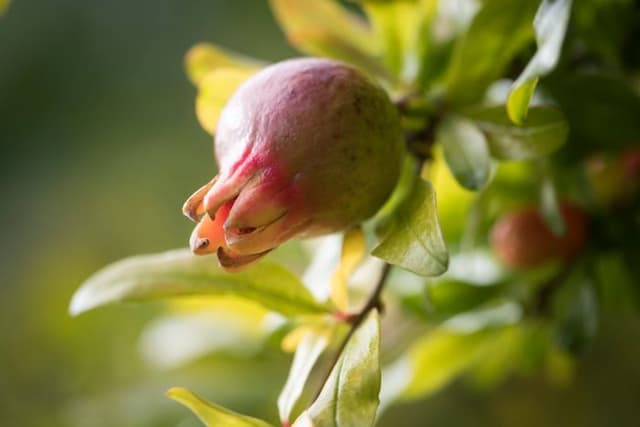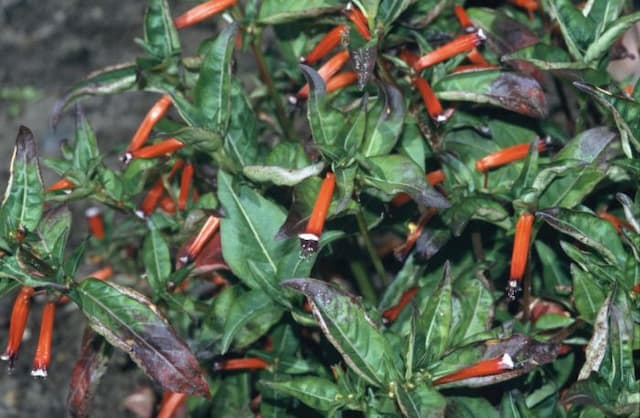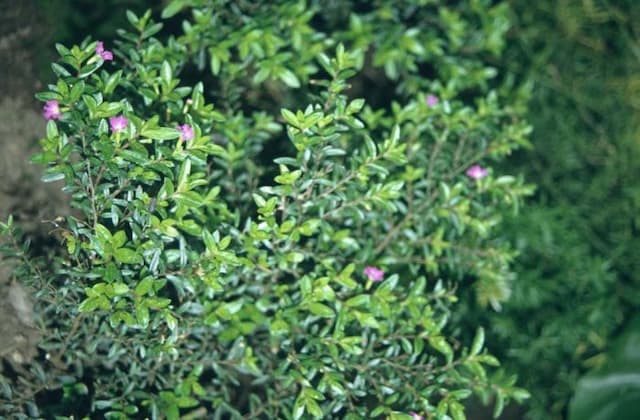Crape myrtle [Braise d'Été] Lagerstroemia indica Braise d'Été = 'Indybra' (PBR) (Indya Charms Series)
![crape myrtle [Braise d'Été]](/_next/image?url=https%3A%2F%2Fplants-admin.emdemapps.com%2Fimages%2Fplants%2F%2Fimages%2F604b63ea2652e.png&w=3840&q=75)
ABOUT
[Braise d'Été] is a bushy, upright shrub with dark green foliage that is flushed red in spring and turns yellow-orange in autumn. Dark reddish-pink flowers with crinkled petals are produced in large, terminal clusters in summer
About this plant
 Names
NamesSynonyms
Crepe Myrtle, Crape Myrtle.
Common names
Lagerstroemia indica Braise d'Été = 'Indybra' (PBR) (Indya Charms Series).
 Characteristics
CharacteristicsLife cycle
Perennials
Foliage type
Deciduous
Color of leaves
Green
Flower color
Pink
Height
3-4 feet (0.91-1.22 meters)
Spread
3-4 feet (0.91-1.22 meters)
Plant type
Shrub
Hardiness zones
7
Native area
Asia
Benefits
 General Benefits
General Benefits- Decorative Appeal: The Lagerstroemia indica Braise d'Été offers vibrant blooms that enhance the aesthetic of gardens and landscapes.
- Drought Tolerance: Once established, this crape myrtle variety is tolerant to drought, reducing the need for frequent watering.
- Compact Size: With its smaller stature, it is well-suited for small gardens or spaces where larger trees cannot fit.
- Long Blooming Period: It has a long flowering season, which provides colorful interest throughout the warmer months.
- Low Maintenance: Requiring minimal pruning and care, this crape myrtle is ideal for those seeking a low-maintenance landscaping option.
- Pest and Disease Resistance: This particular variety is bred to be resistant to common pests and diseases that affect crape myrtles, ensuring a healthier plant.
- Versatility: It can be used in various landscape designs, including as a specimen plant, in mixed borders, or in container gardens.
- Attracts Wildlife: The flowers attract pollinators such as bees and butterflies, which are beneficial for the ecosystem.
- Fall Interest: Even after the blooming period, it offers interest with its attractive fall foliage.
- Improved Cultivar: Being part of the Indya Charms Series, it benefits from selective breeding for improved characteristics such as flower color and plant form.
 Medical Properties
Medical PropertiesThis plant is not used for medical purposes.
 Air-purifying Qualities
Air-purifying QualitiesThis plant is not specifically known for air purifying qualities.
 Other Uses
Other Uses- Lagerstroemia indica (crepe myrtle) can be used in woodworking to create small decorative items, such as jewelry boxes or picture frames, due to its attractive grain and color.
- The bark of crepe myrtle can be used in crafting for its unique texture and pattern, potentially for creating natural-looking surface designs in mixed media art projects.
- Dried crepe myrtle flowers can be incorporated into potpourri mixes for their subtle color and shape, adding variety to the composition.
- The wood of crepe myrtle, being quite dense and hard, is suitable for making musical instruments such as flutes or small percussion instruments.
- Crepe myrtle branches can be used in floral arrangements as a sturdy and visually interesting support for other, more delicate flowers.
- Pressed crepe myrtle leaves and flowers can be used in herbarium collections or for educational purposes to study plant morphology and botany.
- Young, flexible branches of crepe myrtle can be used in basket weaving to add a unique, ornamental flair to the final product.
- Crepe myrtle sawdust can be mixed with other materials to create a natural filler or stuffing for eco-friendly toys or pillows.
- The smooth bark can be used as a natural canvas for artists who specialize in painting or etching on wood.
- Creative gardeners may train crepe myrtle branches into living garden structures like arches or trellises, due to their pliability when young.
Interesting Facts
 Feng Shui
Feng ShuiThe plant Lagerstroemia indica, commonly known as the Crape Myrtle, is not typically used in Feng Shui practice.
 Zodiac Sign Compitability
Zodiac Sign CompitabilityThe Crape Myrtle is not used in astrology practice.
 Plant Symbolism
Plant Symbolism- Beauty and Delicacy: Lagerstroemia indica, commonly known as Crape Myrtle, often symbolizes beauty and delicacy due to its delicate flowers and elegant appearance.
- Resilience and Longevity: The Crape Myrtle is known for its tough bark and ability to withstand hot conditions, making it a symbol of resilience and longevity.
- Love and Romance: With its attractive blooms, often used in ornamental gardens, the Crape Myrtle can represent love and romance.
- Purity and Innocence: The purity of the Crape Myrtle's flowers is sometimes seen as a representation of innocence, especially in Eastern cultures.
 Water
WaterCrape myrtles, including Lagerstroemia indica 'Braise d'Été', should be watered deeply once a week during their growing season, with a particular focus on the roots rather than the leaves to avoid fungal diseases. In the absence of rainfall, watering should be increased to twice a week. Newly planted crape myrtles require more frequent watering, every two to three days, to help establish their root system. During the dormant season, reduce watering to every two to three weeks, providing about 1 to 1.5 gallons per watering session, depending on the size and maturity of the plant.
 Light
LightCrape myrtles thrive in full sun, requiring at least six hours of direct sunlight daily to bloom optimally. The ideal spot for a crape myrtle is in a location where it has unobstructed access to sunlight without shading from taller trees or structures. Some light afternoon shade might be beneficial in extremely hot climates, but otherwise, full sun exposure is best.
 Temperature
TemperatureCrape myrtles are heat-loving plants and perform well in a temperature range of 60°F to 95°F, which are typical conditions during their active growth period. They can withstand minimum winter temperatures down to about 0°F, but they may die back to the ground if temperatures drop below this threshold. Ideally, crape myrtles should experience warm temperatures during the growing season for robust growth and flowering.
 Pruning
PruningCrape myrtles benefit from pruning to shape the plant, encourage vigorous growth, and enhance blooming. The best time to prune is late winter or early spring before new growth begins. Thin out crowded branches and remove any dead or diseased wood. Annual light pruning to remove spent flowers and seed heads can increase the next round of blooms, but avoid heavy pruning, which can lead to weak growth and fewer flowers.
 Cleaning
CleaningAs needed
 Soil
SoilCrape Myrtle prefers well-drained soil with a pH of 5.0 to 6.5; mix loam, compost, and perlite for the best soil structure.
 Repotting
RepottingCrape Myrtles need repotting every 2-3 years to refresh the soil and accommodate root growth.
 Humidity & Misting
Humidity & MistingCrape Myrtle thrives at average humidity levels; it's flexible but avoid overly dry air.
 Suitable locations
Suitable locationsIndoor
Ensure full sun, room to grow, and well-draining soil.
Outdoor
Plant in full sun, well-draining soil, and water deeply.
Hardiness zone
7-9 USDA
 Life cycle
Life cycleLagerstroemia indica Braise d'Été, commonly known as the Crape Myrtle, begins its life as a seed, which upon germination, grows into a sapling. The sapling gradually develops into a shrub or small tree, forming a well-branched structure with multiple stems. During spring, the Crape Myrtle enters its active growth phase, producing vibrant green leaves and then flowering in the summer with clusters of crinkled flowers that can be red, pink, purple, or white. Post-blooming, the flowers give way to small, brown capsule-like fruits that release seeds, completing the reproductive cycle. In the fall, the leaves may turn attractive shades of yellow, orange, or red before falling off as the plant enters dormancy in winter. Throughout its life, which can span several decades, the Crape Myrtle can experience pruning and shaping, which is often done to encourage a more desirable form and enhance blooming.
 Propogation
PropogationPropogation time
Spring to Summer
The most popular method of propagation for the Crepe Myrtle 'Braise d'Été' 'Indybra' is through semi-hardwood cuttings, a technique often employed during the summer months when the plant's growth is mature yet still somewhat pliable. To propagate by cuttings, gardeners should select healthy, non-flowering stems from the current year's growth and cut sections about 4 to 6 inches (10 to 15 centimeters) in length. Leaves on the lower half of the cutting should be removed, and the cut end may be treated with a rooting hormone to enhance root development. The prepared cuttings are then inserted into a well-draining potting mix, ensuring at least two nodes are beneath the soil surface where roots can develop. The cuttings require a warm, humid environment to root successfully, which can be achieved by covering them with a plastic bag and placing them in indirect light until they root within several weeks.




